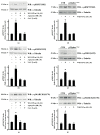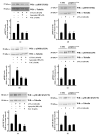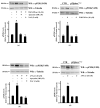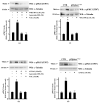Pro-Resolving FPR2 Agonists Regulate NADPH Oxidase-Dependent Phosphorylation of HSP27, OSR1, and MARCKS and Activation of the Respective Upstream Kinases
- PMID: 33477989
- PMCID: PMC7835750
- DOI: 10.3390/antiox10010134
Pro-Resolving FPR2 Agonists Regulate NADPH Oxidase-Dependent Phosphorylation of HSP27, OSR1, and MARCKS and Activation of the Respective Upstream Kinases
Abstract
Background: Formyl peptide receptor 2 (FPR2) is involved in the pathogenesis of chronic inflammatory diseases, being activated either by pro-resolving or proinflammatory ligands. FPR2-associated signal transduction pathways result in phosphorylation of several proteins and in NADPH oxidase activation. We, herein, investigated molecular mechanisms underlying phosphorylation of heat shock protein 27 (HSP27), oxidative stress responsive kinase 1 (OSR1), and myristolated alanine-rich C-kinase substrate (MARCKS) elicited by the pro-resolving FPR2 agonists WKYMVm and annexin A1 (ANXA1).
Methods: CaLu-6 cells or p22phoxCrispr/Cas9 double nickase CaLu-6 cells were incubated for 5 min with WKYMVm or ANXA1, in the presence or absence of NADPH oxidase inhibitors. Phosphorylation at specific serine residues of HSP27, OSR1, and MARCKS, as well as the respective upstream kinases activated by FPR2 stimulation was analysed.
Results: Blockade of NADPH oxidase functions prevents WKYMVm- and ANXA1-induced HSP-27(Ser82), OSR1(Ser339) and MARCKS(Ser170) phosphorylation. Moreover, NADPH oxidase inhibitors prevent WKYMVm- and ANXA1-dependent activation of p38MAPK, PI3K and PKCδ, the kinases upstream to HSP-27, OSR1 and MARCKS, respectively. The same results were obtained in p22phoxCrispr/Cas9 cells.
Conclusions: FPR2 shows an immunomodulatory role by regulating proinflammatory and anti-inflammatory activities and NADPH oxidase is a key regulator of inflammatory pathways. The activation of NADPH oxidase-dependent pro-resolving downstream signals suggests that FPR2 signalling and NADPH oxidase could represent novel targets for inflammation therapeutic intervention.
Keywords: HSP-27; MARCKS (Myristolated Alanine-Rich C-Kinase Substrate); NADPH oxidase (Nicotinamide Adenine Dinucleotide Phosphate oxidase); OSR1 (Oxidative-Stress-Responsive kinase 1); annexin A1; formyl peptide receptors; inflammation; reactive oxygen species.
Conflict of interest statement
The author(s) declare(s) that there is no conflict of interest regarding the publication of this paper.
Figures





Similar articles
-
Formyl-Peptide Receptor 2 Signaling Modulates SLC7A11/xCT Expression and Activity in Tumor Cells.Antioxidants (Basel). 2024 Apr 30;13(5):552. doi: 10.3390/antiox13050552. Antioxidants (Basel). 2024. PMID: 38790657 Free PMC article.
-
Regulation of Inflammation and Oxidative Stress by Formyl Peptide Receptors in Cardiovascular Disease Progression.Life (Basel). 2021 Mar 15;11(3):243. doi: 10.3390/life11030243. Life (Basel). 2021. PMID: 33804219 Free PMC article. Review.
-
Phosphoproteomic analysis sheds light on intracellular signaling cascades triggered by Formyl-Peptide Receptor 2.Sci Rep. 2019 Nov 29;9(1):17894. doi: 10.1038/s41598-019-54502-6. Sci Rep. 2019. PMID: 31784636 Free PMC article.
-
Formyl Peptide Receptor 2-Dependent cPLA2 and 5-LOX Activation Requires a Functional NADPH Oxidase.Antioxidants (Basel). 2024 Feb 8;13(2):220. doi: 10.3390/antiox13020220. Antioxidants (Basel). 2024. PMID: 38397818 Free PMC article.
-
Distinct signaling cascades elicited by different formyl peptide receptor 2 (FPR2) agonists.Int J Mol Sci. 2013 Apr 2;14(4):7193-230. doi: 10.3390/ijms14047193. Int J Mol Sci. 2013. PMID: 23549262 Free PMC article. Review.
Cited by
-
FPR2 serves a role in recurrent spontaneous abortion by regulating trophoblast function via the PI3K/AKT signaling pathway.Mol Med Rep. 2021 Dec;24(6):838. doi: 10.3892/mmr.2021.12478. Epub 2021 Oct 5. Mol Med Rep. 2021. PMID: 34608500 Free PMC article.
-
Formyl-Peptide Receptor 2 Signaling Modulates SLC7A11/xCT Expression and Activity in Tumor Cells.Antioxidants (Basel). 2024 Apr 30;13(5):552. doi: 10.3390/antiox13050552. Antioxidants (Basel). 2024. PMID: 38790657 Free PMC article.
-
NOX Dependent ROS Generation and Cell Metabolism.Int J Mol Sci. 2023 Jan 20;24(3):2086. doi: 10.3390/ijms24032086. Int J Mol Sci. 2023. PMID: 36768405 Free PMC article. Review.
-
Formyl-peptide receptor 2 signalling triggers aerobic metabolism of glucose through Nox2-dependent modulation of pyruvate dehydrogenase activity.Open Biol. 2023 Oct;13(10):230336. doi: 10.1098/rsob.230336. Epub 2023 Oct 25. Open Biol. 2023. PMID: 37875162 Free PMC article.
-
Aquaporin-8 promotes human dermal fibroblasts to counteract hydrogen peroxide-induced oxidative damage: A novel target for management of skin aging.Open Life Sci. 2024 Feb 16;19(1):20220828. doi: 10.1515/biol-2022-0828. eCollection 2024. Open Life Sci. 2024. PMID: 38465340 Free PMC article.
References
LinkOut - more resources
Full Text Sources
Other Literature Sources
Molecular Biology Databases
Research Materials
Miscellaneous

